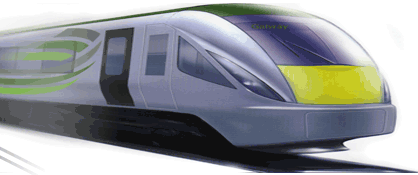West=On=Track
History
'The Other Burma
Road'
See also Burma Road Photo Gallery
1981 courtesy of Michael Fox
An integral part of the Sligo to Limerick "Western Rail
Corridor" is the still extant but long disused rail line
from Collooney Junction, located on the Sligo to Dublin main
line, running through the towns of Tobercurry, Charlestown,
Swinford and Kiltimagh, to the junction with the Westport -
Dublin rail line at Claremorris. This stretch of line, which
opened on 1st October 1895, is known more widely as "The
Burma Road".
For some time now, communities along this rail route have
been growing rapidly in terms of population and business,
with increasing passenger and freight traffic volumes, and
it is now the opinion of a great many people that the towns
concerned and their hinterlands would benefit greatly from
the reopening of the line, as part of a new Western Rail
Corridor running from Sligo to Galway, Limerick, and
beyond.
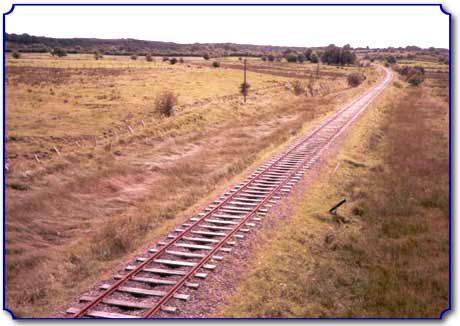
Burma Road near
Carrowmore
Readers will note that in the heyday of the line a
journey from Sligo to Claremorris, was described in railway
parlance as being in the "up" direction, with travel in the
opposite direction being designated as "down the line".
Hence the term, "down to Sligo".
Although severed at Collooney Junction and with less than
straightforward access at the Claremorris end the rail line
remains entirely intact, although covered in places by
tarred road crossings.
The line, or "permanent way" as it is more correctly
described, appears to be in remarkably good condition
throughout, with many stretches free of encroaching
vegetation and any attempts by nature to reclaim the
track-bed.
This, in spite of the fact that, since the closure of the
line to passenger traffic on 15th June 1963, and its final
closure to the remaining freight traffic on 30th October
1975, no timetabled trains have traversed the line.
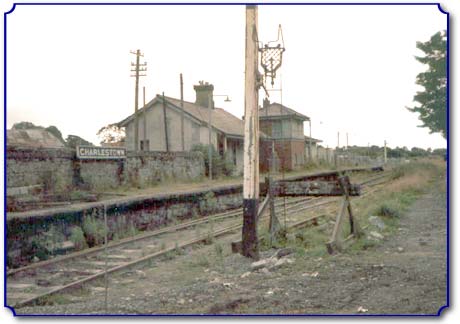
Charlestown Station
1981
An interesting movement did take place however, in 1988,
involving the "propulsion" of 2 redundant CIE passenger
carriages in front of an Irish Rail diesel locomotive from
Claremorris to the recently restored railway station at
Kiltimagh. These were to become an important part of the
Kiltimagh town museum that had been established in the
adjacent goods store. The museum itself adjoins a fine
"sculpture park" that includes a very fine metal figure of a
Station Master in full uniform, complete with stopwatch,
standing large as life on the restored station platform.
Where, one might ask, did "The Burma Road" nickname for
the Collooney to Claremorris railway originate?
The answer lies in the difficult terrain through which
the railway runs, traversing both bogland and rocky
landscapes. Clearly, it must have required great engineering
skills in its construction at the close of the nineteenth
century. Inspired by the infamous "Burma Road" built, as a
"supply" line, by British and other prisoners of war during
the Second World War through the jungles of Burma, the
Collooney to Claremorris line was nicknamed "The Burma
Road", a title which endures to this day.
For those interested in learning more, I would recommend
the following two excellent publications detailing the story
of "The Burma Road":
- "The Great Southern & Western Railway" by K A
Murray & D B McNeill (published by the Irish Railway
Record Society).
- "The Burma Road" - Claremorris to Collooney Railway -
by M Comer & M Murphy (published by Swinford
Historical Society).
My personal link to "The Burma Road" is that one of my
maternal forebears was, at the time of the construction of
the railway, a "lockspitter" (working on the permanent way),
on the Swinford to Charlestown section, and my earliest
recollections of the line stem from family holidays spent
with grandparents in the Swinford area, from Birmingham, in
the 1950's and 1960's.
I particularly recall a visit to Swinford station one
sunny Summer evening in the early 1960's to meet a favourite
uncle returning home from his job in the construction
industry in the English Midlands to his farm near that town.
The afternoon train from Limerick to Sligo, consisting of
two railcars green in colour and adorned with the famous CIE
"flying snail" logo, and which he had joined at Claremorris
from the Dublin train, was late arriving in Swinford. It was
quite full and a number of passengers alighted amid the
noisy rattle of the engines and the pungent smell of diesel
fumes. One had a sense that it had "laboured" throughout its
long journey up the West coast of Ireland. It drew off as
noisily as it had arrived, scheduled to take another one and
a half hours or so to complete its journey to Sligo.
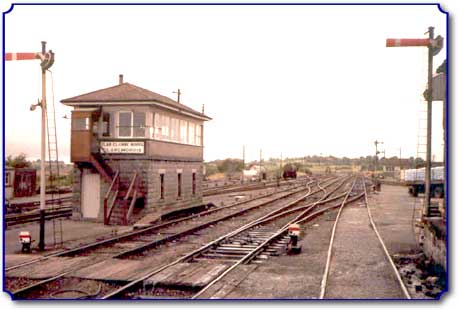
Claremorris - Sligo Line
1981
One of my prized possessions is a copy of the CIE
Passenger Train Timetable for Winter 1958/59, costing 4d
(four pence in "old" money, that is). This publication,
given to me by Jimmy O'Hara, a Swinford shopkeeper and CIE
agent operating the local bus stop at the time, reveals that
Swinford along with other towns on "The Burma Road" enjoyed
a rail service consisting of one train each way every
weekday. The "up" train originated in Sligo at 8.50 a.m.
arriving in Limerick at 2.35 p.m., with the "down" train
leaving Limerick at 3.15 p.m. and reaching Sligo at 8.35
p.m. Leisurely travel indeed and one can, perhaps, envisage
prolonged stops at stations en route, reminiscent perhaps,
of that memorable scene at "Castletown Station" (or
Ballyglunin, to be precise) in the film "The Quiet Man"
Other treasured Burma Road memorabilia to come into my
possession over the years includes a sign from Charlestown
station directing would be travellers to the ticket office
there, a cast iron sign from a gated crossing near
Kiltimagh, enjoining those crossing the railway at this
point to close the gate after use, under "severe" penalty of
a forty shilling fine from the Great Southern & Western
Railway, and a handwritten journal recording goods train
movements at Kiltimagh Station for the period shortly before
the closure of the line.
In June 1981, during a holiday visit to Swinford I took
it upon myself to make a photographic record of "The Burma
Road" from Collooney Junction to Claremorris. In the course
of undertaking this task, and whilst poking around in
undergrowth by a road crossing near Collooney Station (GS
& WR that is - Collooney having, at its "peak", 2 other
stations, unique for a small village in Ireland!) I
discovered a fine cast iron railway sign relating to the
road crossing. I covered this up with the intention of
returning later to "retrieve" this (probably illegally?), as
a worthy addition to my collection of rail artefacts. On so
doing a few days later, alas, my treasure had been
discovered. The pole to which the sign had been affixed had
been sawn through and its upper part complete with "my" sign
had disappeared.
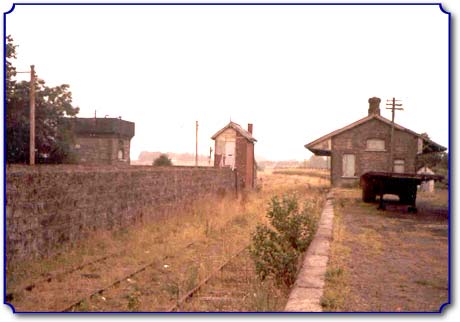
Tobercurry Station
1981
At times in the course of walking the track I paused and
tried to imagine trains still running on the line, huffing
and puffing or "rattling" along amidst an aroma of diesel
fumes, as opposed to the more modern traction, which
appeared on the line before closure. I wondered if, one day,
the trains would run again. Happily, and in response to
modern travelling needs this "reality" may soon again be
upon us.
There are currently schemes underway to clear the line of
trees and vegetation, as part of a programme by
Iarnród Éireann to "reclaim the track". One
hopes that this is with a view to the eventual reopening of
the line and not to make "easier" the passage of a train
employed in the ripping up of the track!
Of course musing and dwelling on history and nostalgia
will not save "The Burma Road" or support the case for its
reopening. My view is that it is up to every town and
community along the line, in common with all other towns on
the Western Rail Corridor, to present their own vision of
what a reopened railway could do for their development and
prosperity, in the Ireland of the 21st century. This should
include submissions on the generation of passenger and
freight traffic in their respective hinterlands, all of
which will add to the gathering momentum for the reopening
of the Western Rail Corridor.
In conclusion, my view is that "The Burma Road" could
easily become an integral part of a network of railcar
services "criss-crossing" Counties Sligo, Mayo, Galway and
Roscommon with stations and "stopping places" convenient to
centres of population and including strategically sited
"park and ride" facilities e.g. on major roads such as the
N17. The Western Rail Corridor could also be utilised for
the movement of freight such as the ever-increasing loads of
timber, relieving roads that, quite often, run parallel to
the railway line.
© Michael Fox
Swinford
|
